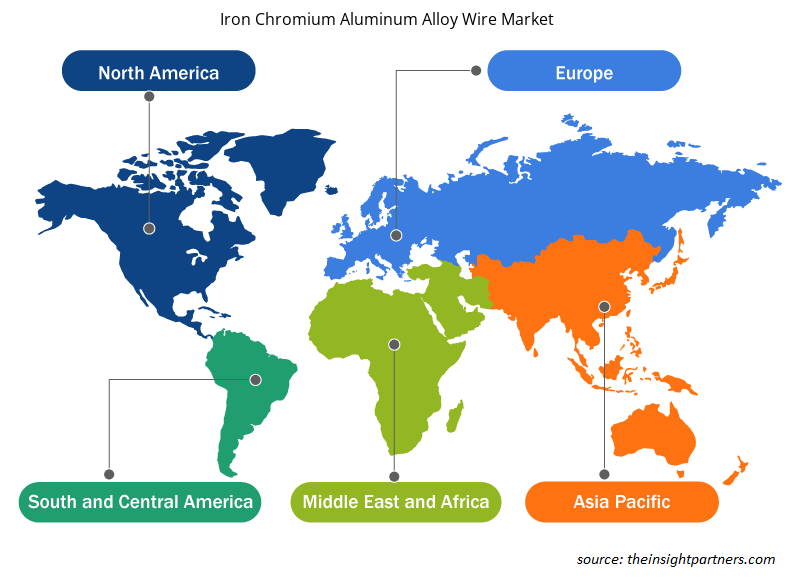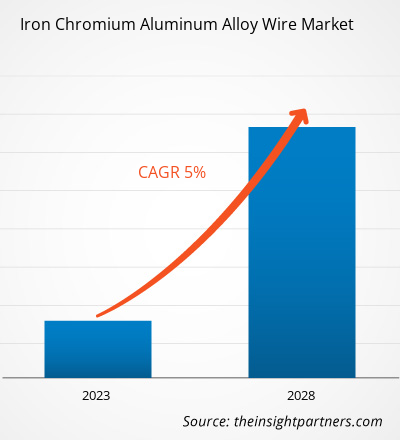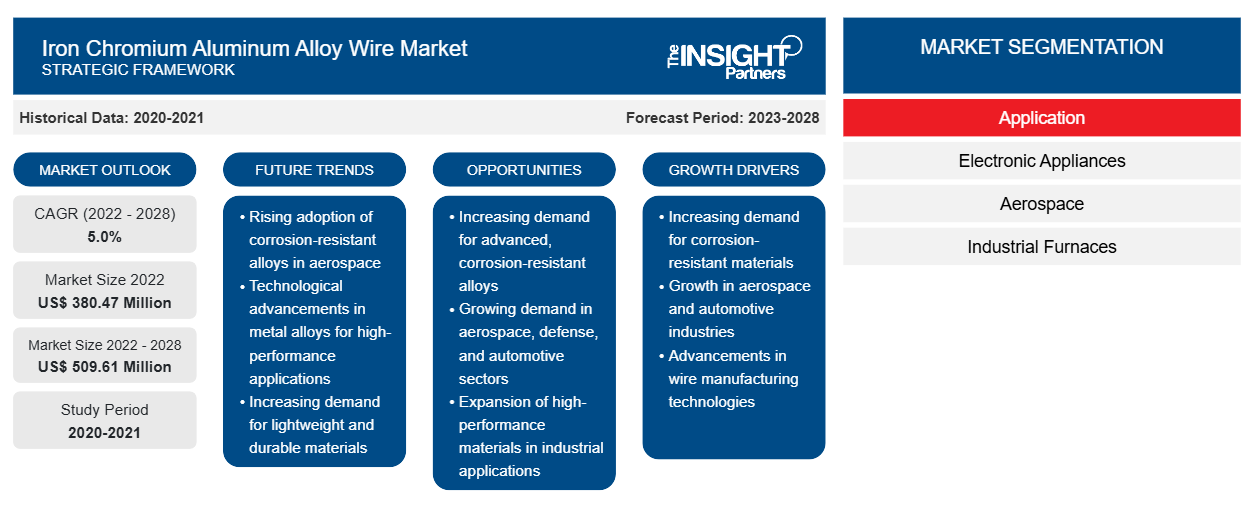[Informe de investigación] Se espera que el tamaño del mercado de alambres de aleación de aluminio, cromo y hierro crezca de US$ 380,47 millones en 2022 a US$ 509,61 millones en 2028; se estima que registrará una CAGR del 5,0% de 2022 a 2028.
Se desarrolló un alambre de aleación de resistencia de hierro-cromo-aluminio (FeCrAl) con el cambio en la composición de los elementos de cromo y aluminio. Ofrece excelentes propiedades antioxidantes, antiazufre y anticementita. También proporciona beneficios como alta carga superficial, alta resistividad eléctrica, alta temperatura de aplicación, vida útil prolongada y asequibilidad. Estos alambres se utilizan como elementos de calentamiento en la industria metalúrgica en procesos como la fusión y el mantenimiento. Los alambres de aleación de hierro-cromo-aluminio (FeCrAl) tienen temperaturas de servicio más altas que las aleaciones de níquel-cromo. Los alambres de FeCrAl son un material económico para aplicaciones de hornos debido a su menor costo y mayor vida útil.
Los alambres de aleación de hierro-cromo-aluminio tienen una temperatura de funcionamiento más alta. La aleación de hierro-cromo-aluminio puede alcanzar una temperatura máxima de servicio de hasta 1.400 °C o 2.550 °F. Los alambres de aleación de hierro-cromo-aluminio tienen una larga vida útil y una gran capacidad de carga superficial. Los alambres tienen una resistencia a la oxidación superior. Las aleaciones de hierro-cromo-aluminio tienen una densidad menor que las aleaciones de níquel-cromo. Se refiere a la disponibilidad de elementos equivalentes que se pueden producir a partir del mismo material de peso. Los alambres de aleación de hierro-cromo-aluminio tienen una resistividad eléctrica más alta. Los alambres también tienen un coeficiente de expansión térmica más bajo que las superaleaciones a base de níquel. Debido a todas estas ventajas, los alambres de aleación de hierro-cromo-aluminio se utilizan ampliamente para elementos de calentamiento en la industria eléctrica y una amplia gama de entornos de oxidación de alta temperatura, como hornos eléctricos industriales, hornos de calentamiento, reactores nucleares, refinerías de petróleo, sistemas de escape de automóviles , electrodomésticos y configuraciones de infrarrojos. Por lo tanto, las ventajas de los alambres de aleación de hierro, cromo y aluminio impulsan el crecimiento del mercado mundial de alambres de aleación de hierro, cromo y aluminio .
En 2022, Asia Pacífico tuvo la mayor participación en el mercado de alambres de aleación de aluminio, cromo y hierro y se estima que registrará la CAGR más alta durante el período de pronóstico. Las empresas de la región están mejorando continuamente los procesos comerciales generales para satisfacer la demanda de los clientes de productos y servicios de alta calidad de la mejor manera posible.
Personalice este informe según sus necesidades
Obtendrá personalización en cualquier informe, sin cargo, incluidas partes de este informe o análisis a nivel de país, paquete de datos de Excel, así como también grandes ofertas y descuentos para empresas emergentes y universidades.
-
Obtenga las principales tendencias clave del mercado de este informe.Esta muestra GRATUITA incluirá análisis de datos, desde tendencias del mercado hasta estimaciones y pronósticos.
Impacto de la pandemia de COVID-19 en el mercado de alambres de aleación de aluminio, cromo y hierro
Los confinamientos, las restricciones de viaje y los cierres de empresas debido a la pandemia de COVID-19 afectaron negativamente a las economías e industrias de varios países de América del Norte, Europa, Asia Pacífico (APAC), América del Sur y Central, y Oriente Medio y África (MEA). La crisis perturbó las cadenas de suministro globales, las actividades de fabricación, los cronogramas de entrega y las ventas de productos esenciales y no esenciales. Varias empresas anunciaron posibles retrasos en las entregas de productos y una caída en las ventas futuras de sus productos en 2020. Además, las prohibiciones de viajes internacionales impuestas por varios gobiernos en Europa, Asia Pacífico y América del Norte obligaron a varias empresas a interrumpir sus planes de colaboración y asociación. Todos estos factores obstaculizaron la industria de productos químicos y materiales en 2020 y principios de 2021, lo que restringió el crecimiento de varios mercados relacionados con esta industria, incluido el mercado de alambres de aleación de aluminio, cromo y hierro.
Antes del brote de COVID-19, el mercado de alambre de aleación de aluminio, cromo y hierro estaba impulsado principalmente por la creciente demanda de hornos industriales. Sin embargo, en 2020, varias industrias tuvieron que ralentizar sus operaciones debido a las interrupciones en las cadenas de valor causadas por el cierre de las fronteras nacionales e internacionales. La pandemia de COVID-19 interrumpió la cadena de suministro de materias primas clave y alteró los procesos de fabricación debido a las restricciones impuestas por las autoridades gubernamentales en varios países. Dichos factores redujeron la producción de vidrio y cerámica, donde los hornos industriales son muy utilizados.
Perspectivas del mercado
Los avances estratégicos de los actores clave favorecen el crecimiento del mercado de alambres de aleación de aluminio, cromo y hierro
Los actores clave del mercado están adoptando diversas estrategias de marketing, como lanzamientos de productos, fusiones y adquisiciones y colaboraciones. Se espera que estos desarrollos estratégicos de los actores clave del mercado impulsen el crecimiento del mercado de alambres de aleación de aluminio, cromo y hierro.
Información sobre aplicaciones
Según la aplicación, el mercado de alambres de aleación de aluminio, cromo y hierro se segmenta en electrodomésticos, aeroespacial, hornos industriales, metalurgia y maquinaria, entre otros. El segmento de hornos industriales tuvo la mayor participación de mercado en 2022 debido al crecimiento de las actividades industriales.
Entre los principales actores que operan en el mercado de alambres de aleación de aluminio, cromo y hierro se encuentran Smith Therm Pvt. Ltd., JLC Electromet Pvt. Ltd., Changzhou DLX Alloy Co., Ltd., Kanthal AB, Suzhou Nickel Alloy Co., Ltd, Oceania International LLC, Hyndman Industrial Products, Donghai Electric Appliance Co., Ltd., Jiangsu Nickel Alloy Co., Ltd y Temco Industrial LLC. Estas empresas se centran principalmente en la innovación de productos para ampliar el tamaño de su mercado y seguir las tendencias emergentes del mercado.
Perspectivas regionales del mercado de alambre de aleación de aluminio, cromo y hierro
Los analistas de Insight Partners explicaron en detalle las tendencias y los factores regionales que influyen en el mercado de alambres de aleación de aluminio, cromo y hierro durante el período de pronóstico. Esta sección también analiza los segmentos y la geografía del mercado de alambres de aleación de aluminio, cromo y hierro en América del Norte, Europa, Asia Pacífico, Oriente Medio y África, y América del Sur y Central.

- Obtenga datos regionales específicos para el mercado de alambre de aleación de aluminio, cromo y hierro
Alcance del informe de mercado de alambre de aleación de aluminio, cromo y hierro
| Atributo del informe | Detalles |
|---|---|
| Tamaño del mercado en 2022 | US$ 380,47 millones |
| Tamaño del mercado en 2028 | US$ 509,61 millones |
| CAGR global (2022-2028) | 5.0% |
| Datos históricos | 2020-2021 |
| Período de pronóstico | 2023-2028 |
| Segmentos cubiertos |
Por aplicación
|
| Regiones y países cubiertos |
América del norte
|
| Líderes del mercado y perfiles de empresas clave |
|
Densidad de actores del mercado de alambres de aleación de aluminio, cromo y hierro: comprensión de su impacto en la dinámica empresarial
El mercado de alambres de aleación de aluminio, cromo y hierro está creciendo rápidamente, impulsado por la creciente demanda de los usuarios finales debido a factores como la evolución de las preferencias de los consumidores, los avances tecnológicos y una mayor conciencia de los beneficios del producto. A medida que aumenta la demanda, las empresas amplían sus ofertas, innovan para satisfacer las necesidades de los consumidores y aprovechan las tendencias emergentes, lo que impulsa aún más el crecimiento del mercado.
La densidad de actores del mercado se refiere a la distribución de las empresas o firmas que operan dentro de un mercado o industria en particular. Indica cuántos competidores (actores del mercado) están presentes en un espacio de mercado determinado en relación con su tamaño o valor total de mercado.
Las principales empresas que operan en el mercado de alambres de aleación de aluminio, cromo y hierro son:
- Compañía Termoeléctrica Smith Pvt. Limitada.
- JLC Electromet Pvt. Limitada.
- Aleación DLX de Changzhou Co., Ltd.
- Kanthal AB
- Suzhou Aleación de níquel Co., Ltd.
Descargo de responsabilidad : Las empresas enumeradas anteriormente no están clasificadas en ningún orden particular.

- Obtenga una descripción general de los principales actores clave del mercado de alambre de aleación de aluminio, cromo y hierro
Informe Destacado
- Tendencias progresivas de la industria en el mercado de alambres de aleación de aluminio, cromo y hierro para ayudar a las empresas a desarrollar estrategias efectivas a largo plazo
- Estrategias de crecimiento empresarial adoptadas por los actores del mercado de alambres de aleación de aluminio, cromo y hierro en países desarrollados y en desarrollo
- Análisis cuantitativo del mercado de 2020 a 2028
- Estimación de la demanda mundial de alambre de aleación de aluminio, cromo y hierro
- Análisis de las cinco fuerzas de Porter para ilustrar la eficacia de los compradores y proveedores en el mercado de alambres de aleación de aluminio, cromo y hierro
- Avances recientes para comprender el escenario competitivo del mercado
- Tendencias y perspectivas del mercado, así como factores que impulsan y restringen el crecimiento del mercado de alambres de aleación de aluminio, cromo y hierro
- Asistencia en el proceso de toma de decisiones destacando las estrategias de mercado que sustentan el interés comercial.
- Tamaño del mercado de alambres de aleación de aluminio, cromo y hierro en varios nodos
- Descripción detallada y segmentación del mercado y dinámica de crecimiento de la industria del alambre de aleación de aluminio, cromo y hierro
- Tamaño del mercado de alambre de aleación de aluminio, cromo y hierro en varias regiones con oportunidades de crecimiento prometedoras
- Análisis histórico (2 años), año base, pronóstico (7 años) con CAGR
- Análisis PEST y FODA
- Tamaño del mercado, valor/volumen: global, regional y nacional
- Industria y panorama competitivo
- Conjunto de datos de Excel
Informes recientes
Informes relacionados
Testimonios
Razón para comprar
- Toma de decisiones informada
- Comprensión de la dinámica del mercado
- Análisis competitivo
- Información sobre clientes
- Pronósticos del mercado
- Mitigación de riesgos
- Planificación estratégica
- Justificación de la inversión
- Identificación de mercados emergentes
- Mejora de las estrategias de marketing
- Impulso de la eficiencia operativa
- Alineación con las tendencias regulatorias























 Obtenga una muestra gratuita para - Mercado de alambres de aleación de hierro, cromo y aluminio
Obtenga una muestra gratuita para - Mercado de alambres de aleación de hierro, cromo y aluminio